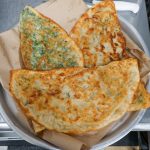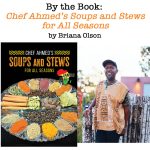Norteña: Authentic Family Recipes from the North of Mexico
by Karla Zazueta
I imagine it is a difficult thing, trying to cook the dishes of your home country while living far away from it. Not only is locating appropriate ingredients hard, but so is locating other people who share that home country and its cuisine, who are nostalgic for the same flavors and textures you are. And perhaps these things would be much easier for Karla Zazueta, author of Norteña: Authentic Family Recipes from the North of Mexico, if she lived in New Mexico, which is both geographically fairly close to Baja California and Sinaloa, the states she spent most of her childhood in, and full of people who would immediately appreciate a table laden with chile rellenos, pozole de pollo, and a simmering pot of rich birria. But instead she lives in London—a city that has its charms, I’ve been told, but is not exactly known for its vast Mexican population, nor for the particularly high spice tolerance of its denizens. It makes sense, then, that the book assumes such a bare minimum of familiarity with Mexican food that it, frankly, may not be useful to many New Mexican readers/cooks, for whom italicizing the word “burrito” may feel like a bit of editorial overkill.
Still, the bare-basics approach in Norteña did get me to make (both corn and flour) tortillas at home for the first time, after which I discovered that, yes, enchiladas made with homemade tortillas are, in fact, noticeably superior. The instructions throughout the book are simple and approachable, and hardly any recipes involve ingredients not readily available at a Smith’s or any other standard-issue grocery store in New Mexico. I appreciated, too, how many of the recipes have vegetarian or vegan alternatives built in, and how the “From the Garden” section is nearly as dense as the “From the Sea” and “From the Ranch” sections. Zazueta also traces various traditional Mexican dishes, in the recipe headnotes and in a few interstitial prose sections, to the Indigenous groups who first made them (the recipe for wakabaki, a rich beef broth made by the Yaqui people; the sweet corn drink called tesgüino, made by the Rarámuri). If the tone of the writing and the recipes offered occasionally comes across as overly simple, it is made up for in the moments when Zazueta does, indeed, teach you something you didn’t know before—and with a kind of nonjudgmental generosity that encourages you to keep trying, keep learning, and stop worrying if the first batch of tamales you make is a bit dry and crumbly.
Which is all to say that if Norteña is a primer in Mexican (and in particular norteño) cookery for the uninitiated, then it’s a good one: easy and engaging to read, updated for twenty-first-century readers, and full of modifications that allow the widest possible audience to access the recipes. If you already have a binder full of tried-and-true recipes for red chile and posole and menudo that do the job well, then Norteña may prove a bit commonplace for you. But if you don’t, then Zazueta is happy to guide you every step of the way.
Who’s Your Source?
The ingredients in Norteña’s recipes are, by and large, commonly available at any old grocery store. That said, for some of the meat dishes that include bone marrow, you might have to go to a real butcher rather than the deli counter at your local grocery—in Albuquerque, we’d recommend Polk’s Folly Butcher Shop and Farm Stand if you don’t mind the drive out to the East Mountains, where they’ll sell you bones with marrow still in them, ready for stewing.
The kinds of dried chiles Zazueta uses most are guajillo and chile de árbol, both of which are pretty standard fare at El Mezquite in Albuquerque and El Paisano in Santa Fe. Mago’s Farm at the Albuquerque Downtown Growers’ Market sells chiles de árbol too.
Robin Babb
Robin Babb is the associate editor of edible New Mexico and The Bite. She is an MFA student in creative writing at the University of New Mexico and lives in Albuquerque with a cat named Chicken and a dog named Birdie.







